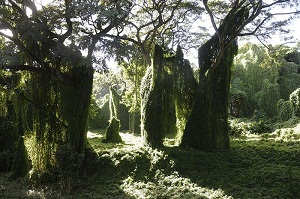 After a little more than 25 years the Grand Metropolitan Park of Havana (GPMH) is once again the biggest provider of oxygen for the capital’s densely populated but sparsely vegetated municipalities.
After a little more than 25 years the Grand Metropolitan Park of Havana (GPMH) is once again the biggest provider of oxygen for the capital’s densely populated but sparsely vegetated municipalities.
Given its diversity of flora, fauna and the neighborhoods located within it, the 700 hundred hectare GPMH, located along the last 9.5 kilometers of the Almendares River, is unlike all other parks in Cuba, the Americas, or the world, where most facilities of this kind are designed to provide temporary enjoyment.
However, the GPMH functions as a recreational space, represents the green “lung” of the capital and is home to over 2,000 citizens living in the neighborhoods of Pogolotti, Cantarrana, La Guayaba, El Fanguito or El Husillo, among others.
What is more, many of the park’s areas of dense vegetation compensate for the scarcity of green spaces in other municipalities such as Central Havana, Old Havana or 10 de Octubre.
However, the park’s natural environment was almost destroyed due to waste dumped by over 200 different workplaces including factories, hospitals, schools, cafes and other establishments, located throughout the area,
Centuries before it acquired its current name in 1989; citizens were already aware of the importance of making use of this natural environment.
When the Spanish arrived in Cuba the area was nothing but forest, so dense that according to the invaders’ chronicles, a bush rat could travel from one side to the other moving from branch to branch.
Indiscriminate felling and social development saw the outstanding habitat shrink to 21% of its original size, only maintained at that level after a process of reforestation undertaken over the last 50 years.
One of the green lungs of the city, the old Botanical Garden of Havana, which fell into a state of disrepair and is currently undergoing an intense restoration program, is also part of today’s park.
The GPMH is located along the Almendares-Vento river basin, the latter contributing 47% of the capital’s water supply. For decades the river waters were polluted by industrial, gastronomic and even residential waste from the communities living on its banks.
As a result of these destructive actions, the Almendares River was slowing dying with less than one percent oxygen and disappearance of all signs of life from its waters.
A restoration process aimed at reversing such a dire situation has seen water oxygen levels rise to between 3.5 and 3.6 milligrams per liter, and although six is the optimum, at least future generations will be able to enjoy the capital’s most important river.
The return of oxygen to the Almendares River brought life with it. Surveys carried out in areas close to the sea confirmed the presence of cat fish, tilapia and shads, among other species of fish.
Directors and workers are proud of their efforts to restore life to the park, noting that education has been key to the success of the initiative thus far.
In order to manage pollution, prevent the death of flora and fauna, and revive the river and its surrounding areas, efforts were centered on cultural-recreational initiatives, social and community work, as well as educational workshops held in workplaces located along the banks of the Almendares.
In all cases, ecological and sometimes radical solutions were sought, such as closing the paper factories located up by Puentes Grandes, which produced large amounts of harmful waste given their outdated technology.
Another solution was found by opening the María del Carmen waste-water treatment and sewage system plant, which cleared the river of almost all pollution.
Likewise bamboo – which in addition to reducing soil erosion, is resistant to floods – has been planted along the river as part of reforestation efforts undertaken in the area.
A nostalgic place which reminds Havana residents of their childhood, perhaps the site of their first romance, or the place they relaxed with friends on the weekend, the Almendares Park is becoming popular again, following the implementation of various programs by the GPMH directorate.
This is why every weekend thousands of people come to enjoy the cultural andrecreational options offered in this patch of green in the city.
(Prensa Latina)